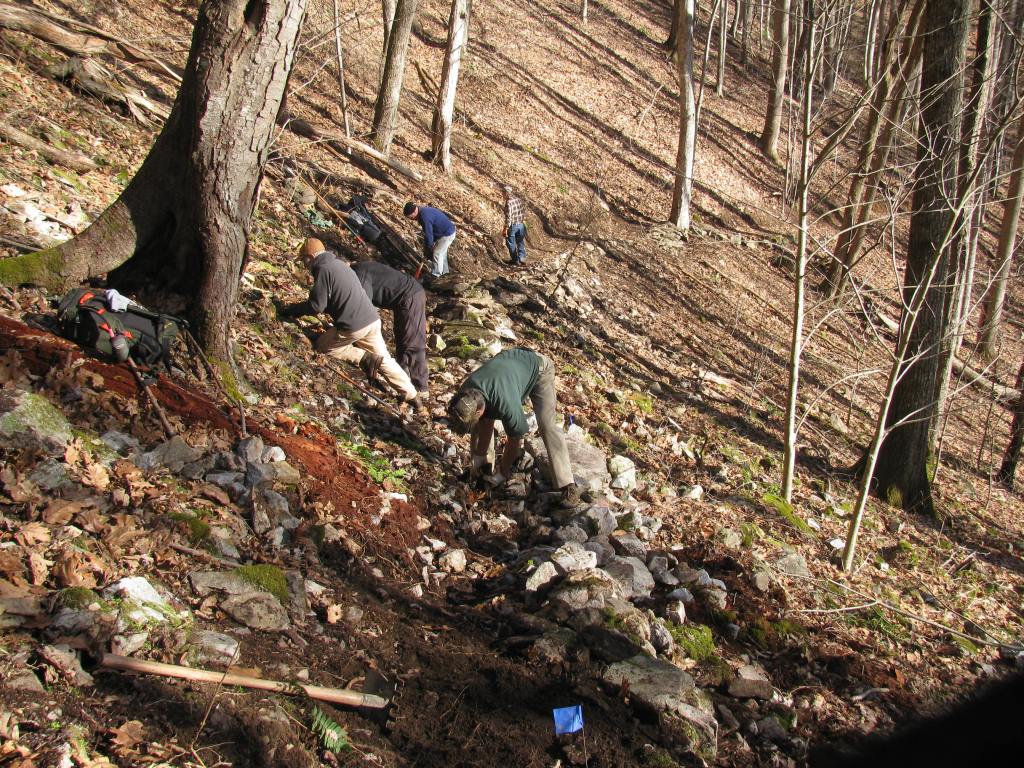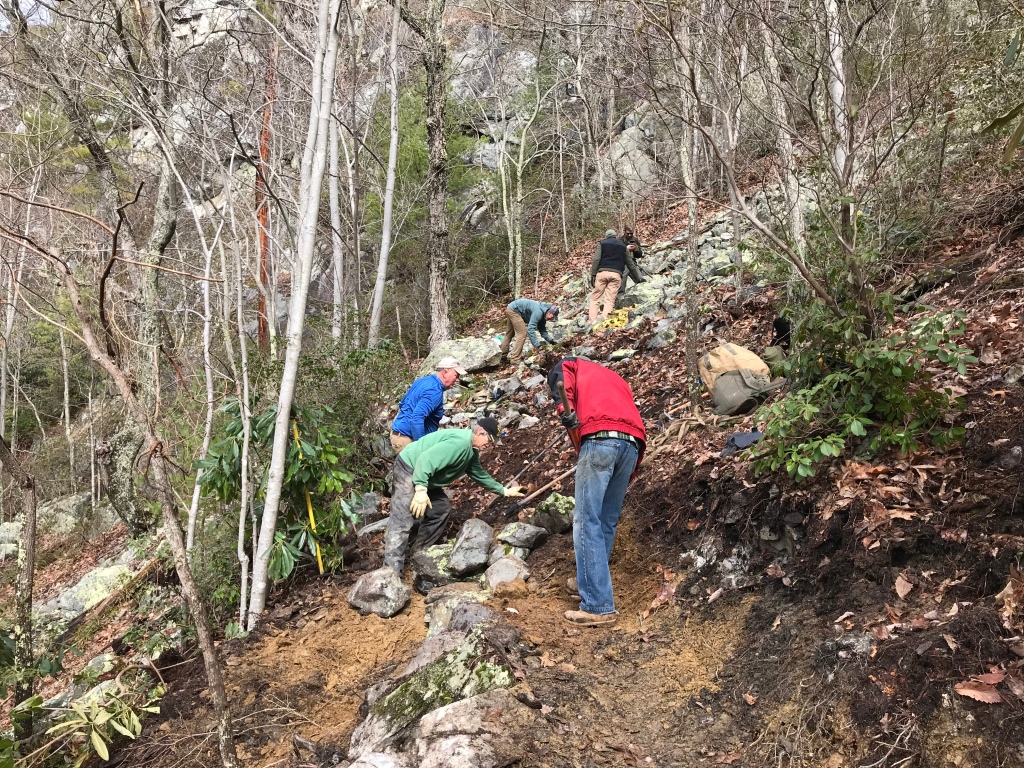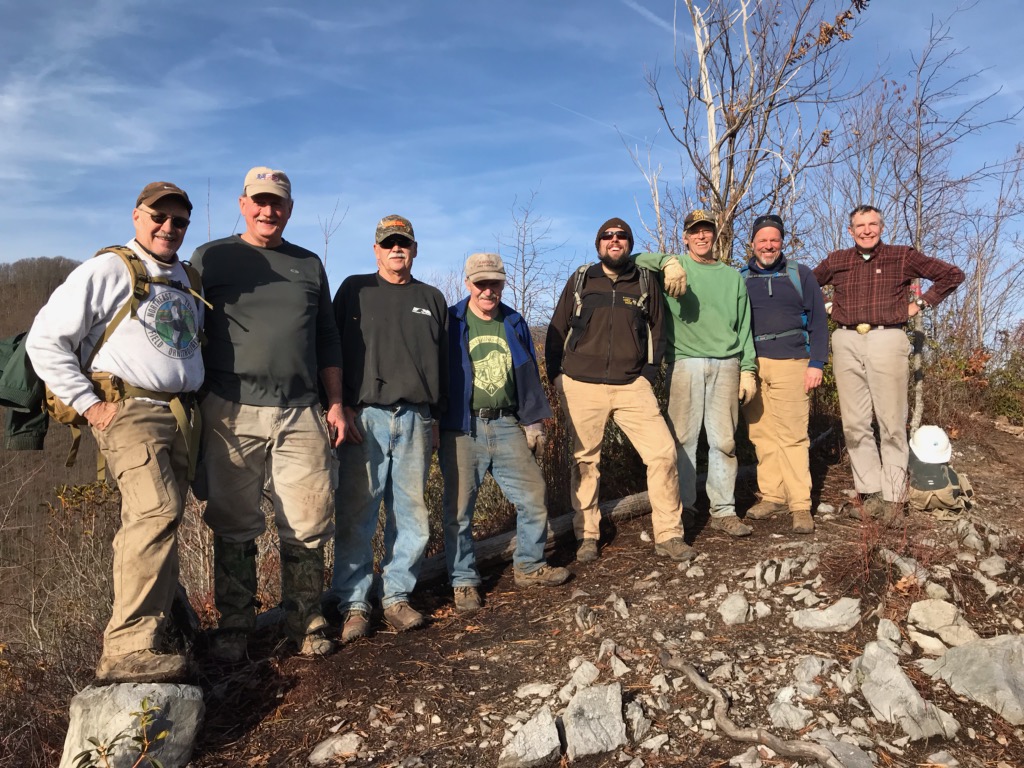
We are so fortunate to live in an area with a great deal of public land where we can get out and experience the natural world—more often than not by hiking the many trails. For many hikers there comes a time when they realize the government does not build and maintain those trails, volunteers do, and the hiker becomes a trail worker. Trail workers find the enjoyment of working in the woods with their friends equal to, if not greater than, that of a simple hike, and the satisfaction of giving something back can be downright addictive.
The 10,000-acre Rocky Fork Tract is crisscrossed by numerous old roads and trails long used by hikers, and a few years after the tract was acquired for public use and a portion became Rocky Fork State Park, volunteers began working on the existing trails there. A volunteer trail crew evolved that worked with park staff to remove blowdowns, cut back vegetation, and build bridges at stream crossings.
One of the more popular existing trails in the park, The Whitehouse Cliffs Trail posed some very serious problems, running right up a small creek, crossing property lines, and eventually going very steeply up a rocky slope to a spectacular 360-degree view. Being the closest trail to the park entrance and offering the best view in the park, a new trail was needed. There was talk of obtaining grant money for a new trail, using a trail dozer that could do most of the work, and hiring trail crews to build the new trail in what was expected to become about a three-year project. With none of that assistance in sight, the staff and volunteer trail crew began, on National Public Lands Day, September 26, 2018, to build the new trail the old-fashioned way, with hand labor.


The call went out for volunteers and they showed up, enjoyed the work, and quickly took the new trail out of sight of the parking lot and up the mountain. Then, in December, the government shutdown began and trail volunteers were banished from federal lands. People passionate about trails didn’t want to stop working on them just because the federal government was not working, and the Carolina Mountain Club asked, “Hey, that’s state-owned land, right? Can we come help?” Absolutely! Much progress was made during the 35-day shutdown and all of a sudden the new trail was halfway up the mountain.

By the end of January, the shutdown had ended, Carolina Mountain Club had gone back to national forest lands, and the trail dozer had shown up, but was ineffective on the sleep slopes and rough terrain. The Rocky Fork Crew continued the work and reached the most challenging area to be tackled, a boulder field below the cliffs. The crew spent many days working in this boulder field moving tons of rock to create a small “bench” through the rock field to walk on. The view from this spot—of the cliffs themselves and the distant mountains and ridges—was spectacular and the crew repeatedly commented about what a great place they had to work. Once past the hardest part, it felt like they had success in hand, even though there was still a great deal of work to do.




Volunteers kept coming, even though it was now quite a walk up the new trail to the work site, including folks from Carolina Mountain Club, Tennessee Eastman Hiking and Canoeing Club, and Friends of Rocky Fork State Park. One-day work trips brought a group from Nuclear Fuel Services in Erwin, students from ETSU, Carolina Climbers Coalition members and some big strong teenagers from Holston Home for Children. The closer to the top the trail got the less soil there was to work with and it became mostly rock work, which is very slow and difficult, so even though the summit could be seen close by above, progress to reach it was slow. The rocky top of the mountain provides a nice, sunny location with numerous hiding spots for timber rattlesnakes, which were seen sunning themselves as they prepared to den up for the winter. The crew felt privileged to see these beautiful creatures and, combined with the forest and stunning views, the reason for public lands and trails was abundantly clear.


So now, as we approach the new year, a gift for everyone is completed: A beautiful new trail to a spectacular 360-degree view of the Southern Appalachian Mountains at their finest—cost to the tax-payers essentially zero. On 58 work days, 99 volunteers and 4 park staffers contributed 2,496 hours of work, 2,208 by volunteers, to build just over one and a quarter mile of trail. The trail includes 175 stone steps, hundreds of feet of rock cribbing to support the trail on steep slopes, and 75 locust-log steps. The federal government values volunteer labor at about $25 an hour, and at that rate the volunteer labor alone on this project is worth more than $55,000.

The crew on this project worked really hard, in difficult terrain, but enjoyed every minute of it and felt privileged to build a trail that everyone can enjoy for years to come. Volunteers always get more in return for their effort than they put in and this project is no exception. So many of us love to hike, and someone, most often volunteers, built and cared for the trails we walk on. When we volunteer ourselves, we re-pay the debt we owe to the stewards of the past that paved the way for us until that day when we became aware that it takes volunteers, and we became trail workers as well as trail walkers.
The park staff has said they anticipate opening the trail on January 1, 2020. Check the Rocky Fork State Park’s web site and Facebook page for updates.

These are your trails; it’s your turn. Volunteer.
All images courtesy of Van Hovey, trail Gorilla.

John, great work and article, I’ll plan on hiking it this year for sure. I’m still recovering from the broken foot, no “Walking boot” anymore but no hiking for a while longer the dr. says. Will
LikeLike
nJohn,
Thanks for the great article, and for all you and your team did on this trail.
Jeff
On Sat, Dec 21, 2019 at 10:57 AM Rocky Fork Journal wrote:
> jpbodacious posted: ” View of Whitehouse Cliffs from the new trail We are > so fortunate to live in an area with a great deal of public land where we > can get out and experience the natural world—more often than not by hiking > the many trails. For many hikers there comes a tim” >
LikeLike
Fantastic job, Gorillas!
Sent from my iPad
>
LikeLike
Just hiked this trail for the first time last week and was AMAZED at what a superbly built trail it was. My hiking partner and I remarked numerous times about “all the work that went into building this”. 5 or 6 years ago I had hiked to Whitehouse Cliffs via the old route, and gosh what a dreadful hike. I mean, I’m used to long, hard hikes, but all those huge, sharp, pointy rocks along that last part was dreadful. Thank you SO much for all your hard work!! Trust me …. it is well appreciated!!
One question, you mentioned that “boulder field below the cliffs”. When we came upon that we were so struck by how “unnatural” it looked. Is that a naturally occurring phenomenon of a whole section of rocky boulders along a hillside like that?
LikeLike